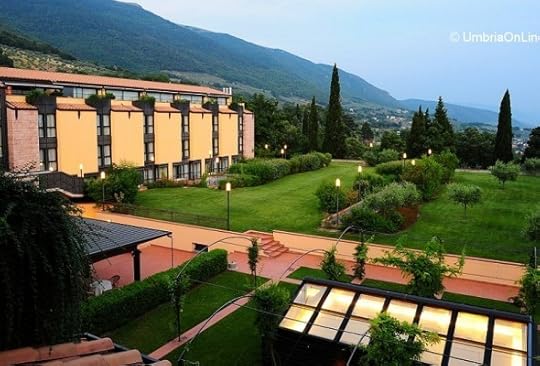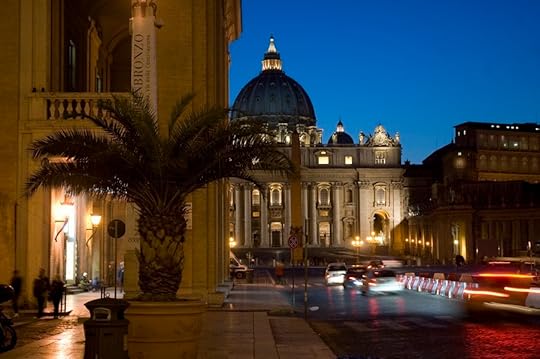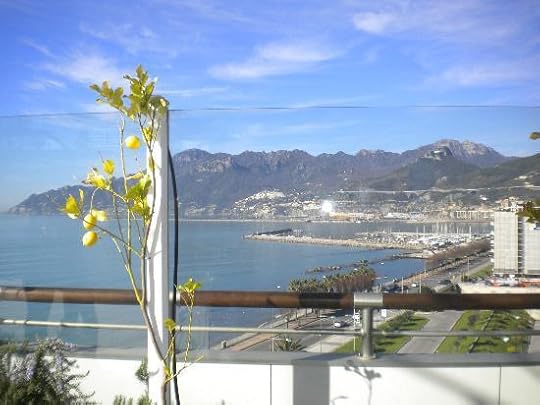Mary DeTurris Poust's Blog, page 41
March 10, 2014
A sneak peek at our Italian hotels
The Italy: A Feast for Body and Soul food-faith pilgrimage is gaining momentum. We’re getting new registrations all the time, so if you want to join us — or even if you’re considering it but haven’t decided for sure — shoot me an email or fill out the online registration form.
“Where will we be staying?” is one of the first questions many people ask about this all-inclusive trip. Well, for starters, we’re staying at 4-star and above hotels, at least two of them true spa hotels. We currently have blocks of rooms booked at the hotels you’ll see below. Of course, until we plunk down our money and finalize those bookings, there’s always a chance things could change, but, even so, we will book at other hotels of equal luxuriousness.
For our first three nights, we plan to stay at the Grand Hotel Croce di Malta. 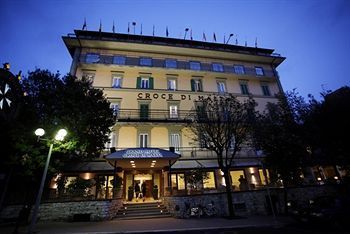 This amazing spa hotel, located on one of the most elegant boulevards in the spa town of Montecatini Terme, will be our base for nearby Florence and Siena. Take a stroll around the website and see for yourself.
This amazing spa hotel, located on one of the most elegant boulevards in the spa town of Montecatini Terme, will be our base for nearby Florence and Siena. Take a stroll around the website and see for yourself.
In Assisi, we plan to spend two nights at the Hotel Roseo, another spa hotel in yet another inspiring and beautiful Italian city. Here are a couple of views of and around that hotel:
Then we head to Rome for three days and three nights with a planned stay at the magnificent Palazzo Cardinal Cesi, located just a few steps away from St. Peter’s Basilica. Take a look. That’s the hotel on the left of the photo, and that’s St. Peter’s. Yeah, amazing.
Finally we head much farther south to the Amalfi Coast. We will be based in Salerno for three nights as we visit Pompeii, Sorrento, the Isle of Capri and Anacapri, and Massa Lubrense, an amazing seaside town which just happens to be the birthplace of my paternal grandfather. (Leading a pilgrimage has its benefits.) This portion of our trip will even include a cooking class and olive oil tasting, as well as a Mass and meal at the Convento di San Francesco.
We plan to stay at the Grand Hotel Salerno. Here’s a view from the roof terrace:
If that doesn’t make you want to get your passport today, I don’t know what will. Again, there’s always a chance one of these hotels will suddenly get booked up before our group has finalized everything, although our travel company tells us that’s an outside chance. And, even if that were to happen, we’d end up in an equally fabulous hotel in whatever amazing Italian city we happen to be visiting at the time.
For more details about the trip, click HERE to view the online registration form. Don’t worry, you can just look around, no need to register at that moment. (Feel free to mute me. As soon as you click on that link, audio will start playing.) Or, if you have questions or just want to talk, send me an email and we can arrange a time to chat. If you haven’t done so already, head to our pilgrimage Facebook page and click like.
Ciao!
The post A sneak peek at our Italian hotels appeared first on Not Strictly Spiritual.

March 8, 2014
Finding long-lost memories in a dresser drawer
My March “Life Lines” column running in the current issue of Catholic New York:
I decided to clean out some dresser drawers last weekend, and mixed in with the shirts I no longer wear and the silks scarves I forgot I had were little pieces of my past. Noah’s handprint in clay from when he was just a year old. A puffy foam heart necklace made by Chiara for a Mother’s Day gone by. Olivia’s old letters to Santa and one to the Tooth Fairy demanding to know what she does with all those teeth anyway.
As I sorted and stored, dusted and dumped, I turned up one memory after another, moments I’d lost that were given back to me just briefly in the guise of a de-cluttering project. And then I stuck my hand into an old silk travel jewelry bag I’d purchased when I was in China 30 years ago, and I pulled out a torn and yellowed envelope. My first name was scrawled across the front in familiar handwriting, my mother’s handwriting, the mother I haven’t seen or heard or smelled or touched in almost 26 years. And I felt a little stunned, like the wind had been knocked out of me for a second or two.
I guess I knew I had this letter. After all I had the forethought to store it inside a plastic bag inside a silk bag with some of my old rings and charms, someplace hidden and protected. But, to be honest, I totally forgot that this letter existed. I have very little in the way of personal mementos belonging to my mother—a necklace, an outdated Sunday missal, the beautiful mahogany wall unit that graced the living room of my childhood home and held some of her own treasures and memories. But those are all “things,” material belongings that really don’t convey much meaning. This letter was another story, like a stolen conversation, a voice from my past.
As I unfolded the letter, I didn’t even need to read a word to feel the connection. Just holding the pages my mother once held and seeing her handwriting and “Mom” signed at the bottom was enough, but as I read on I was so grateful for words I remembered now but had long ago lost sight of. Although the letter wasn’t dated, I could tell from its content that my mother wrote it when I was older—maybe in college or just after, and it was written on my birthday. My mother wrote more of these birthday letters, but this is the only one that survived.
I used to write similar birthday letters to Noah when he was young, and I have journals for each of my three children, not baby books (we have those, too), but actual diary-type books where I write to them about being their mom. Noah’s book has the most entries, Olivia’s just a few, and Chiara’s only one or two. I guess somewhere in my heart and head I remembered how much I loved those notes from my mother and wanted to give my kids the same thing, but life got in the way, as it often does. And while there’s a case to be made for living life in the moment rather than taking notes about it on paper after the fact, finding that letter made me realize that these little glimpses into the past can resonate in powerful ways.
That short handwritten note took me back to a time I’d lost, a love and friendship snatched away too soon. It reminded me that my mother was everything I remembered her to be, not some figment of a child’s imagination. With every passing year, it has become easier and easier to imagine—to assume—that perhaps I had sugar-coated the image of my mother and the relationship we shared. This lost letter proved to me once again that it was all so very real and beautiful.
So excuse me while I put pen to paper and leave some memories for my children.
The post Finding long-lost memories in a dresser drawer appeared first on Not Strictly Spiritual.

March 7, 2014
We are love, we are one…
A little musical inspiration on this first friday of March and first friday of Lent. I love this song, and when I heard it again yesterday as I was driving kids all over town, it felt like the perfect Lenten meditation. Here’s “Nothing More” by The Alternate Routes:
We are Love
We are One
We are how we treat each other when the day is done.
We are Peace
We are War
We are how we treat each other and Nothing More
The post We are love, we are one… appeared first on Not Strictly Spiritual.

March 6, 2014
Lent, Day 2: It’s not too late to tweak your plan
So we’re into our second day of Lent and maybe you’re already thinking whatever you planned for Lent could use a little boost or support. Maybe the fasting part of Ash Wednesday was fine but you felt lacking in the prayer department. It’s not too late to gather up some resources to keep things moving in the right direction or to find a new direction even now, after Lent has officially begun. No one said you can’t change the plan once you’ve started on the path. You can always change the plan, especially if you’re not feeling spiritually fed by what you’re doing. This isn’t about meeting some earthly marker but about growing closer to God.
One our favorite things at the Poust House is CRS Rice Bowl. Every year we put the cardboard “bowl” on the center of our table with a wooden cross and white candle. It’s an exterior reminder of our interior journey of prayer, fasting, and almsgiving, all bringing us closer day by day to the light of Easter. But this year (again) our parish didn’t offer rice bowls. Never fear! CRS has a printable version, so you can make your own. Click HERE and you’ll get the rice bowl art plus access to all the things you would typically get on the printed calendar — daily readings, meatless recipes, stories of faith from the many places around the world where CRS is making a difference.
CRS kicks it up a notch by offering the CRS Rice Bowl app. You can download it for free and set reminders for daily reflections, and you’ll have handheld access to all those same recipes and stories. I’m loving it. I’m going to have my kids download the app to their phones. Even if they read it only a few times, it’s more than they might do otherwise. Either go to your App Store, or click HERE for more information and a link through CRS.
Yesterday, feeling like needed to have a more appropriate Lenten soundtrack as I worked, I purchased Lent at Ephesus, the new CD from the Benedictines of Mary, Queen of Apostles. You may recall that I gushed over their Advent CD two years ago. I often play that one in non-Advent seasons, it’s so good. The beautiful Lenten CD is available directly through the Benedictines of Mary (you can also hear some samples there) and also through Amazon. If you go through Amazon, it comes with AutoRip, meaning you get an immediate MP3 download, so you can start listening, well, now.
And, of course, there are almost endless things you can download or access to support your Lenten plan. If you haven’t seen Give Us This Day, a monthly subscription-based collection of daily readings and reflections, definitely check that out. And not just because I write for them sort of regularly. (You’ll find my reflection on March 21 in the current issue.) Your subscription will come with a digital edition as well as print so you’ll never be without it.
I’ll be back soon with some book recommendations to take you through the rest of Lent and beyond.
The post Lent, Day 2: It’s not too late to tweak your plan appeared first on Not Strictly Spiritual.

March 5, 2014
Ashes to ashes: the journey begins…
I usually enter the Lenten season like gangbusters. Armed with books and plans — overly ambitious plans — I typically approach Ash Wednesday in spiritual attack mode. And by the second or third week of Lent, I’m totally deflated and disappointed. This year has been very different, and I haven’t yet figured out why. I sort of backed into Lent, still pondering my plans right up until I headed to church for Mass and ashes early this morning.
Maybe it’s an age thing. The older I get, the more realistic I become about what I might actually accomplish this Lent, or any other day of my life. I know how easy it is to set giant goals — spiritual or otherwise — and give up in frustration before any new habits have taken root. It’s why I don’t make New Year’s resolutions. So this year, as we begin our 40-day journey through the desert toward resurrection, I am going in with a very different attitude. I’ve packed lighter for this journey. Yes, I still have plans, and they’re still probably too ambitious, but they’re at least a little closer to possible than impossible. And, to be honest, if I do nothing more than revive a couple of favorite prayer practices over the next few weeks, I will consider this special spiritual season a smashing success.
So I hope you’ll join me on the journey. I plan to pop in here with some book recommendations, some updates on how things are going, some spiritual inspiration I find along the way, and some classic Catholic food for thought to spur us on. I’ll try to be here regularly, but at the same time I plan to cut back on the amount of time I spend online, so we’ll have to see how that balances out.
Chiara and I have made a joint pact for Lent: no iPods or laptops, no Flappy Birds (her) or Facebook (me) from dinnertime on, except on non-school nights. She was so happy when I said I would do this with her, I think because she knows if I’m not on Facebook, I’ll have more time for her. We’ve also agreed to some other special activities together during our newly cleared evening schedules. Again, even if that were the only positive thing to happen this Lent, it would be more than enough. So keep in mind that you can do things this Lent that may not be overtly spiritual but have great soul power nonetheless.
So we start this season with the stark reminder that we are dust and to dust we will return. Even if you got the more contemporary refrain with your ashes — Repent and believe in the Gospel — that smudge of ash from last year’s burned palms is reminder enough of our temporary status on this planet. It’s such a beautiful way to begin, stripping it all down to the basics. We are here, but not for long. What do we plan to do with the brief time we have? How important will God figure into those plans? How will we treat others along the way?
Blessings as you begin your own journey through Lent. I will pray for you. Please pray for me.
And here to send us on our way is a poem by Mary Oliver. It came to mind as I was writing this post. Perhaps it’s also not overtly spiritual Lenten fare, but it is full of spirit and soul power appropriate to this season, I think:
When Death Comes
When death comes
like the hungry bear in autumn
when death comes and takes all the bright coins from his purse
to buy me, and snaps his purse shut;
when death comes
like the measle-pox;
when death comes
like an iceberg between the shoulder blades,
I want to step through the door full of curiosity, wondering;
what is it going to be like, that cottage of darkness?
And therefore I look upon everything
as a brotherhood and a sisterhood,
and I look upon time as no more than an idea,
and I consider eternity as another possibility,
and I think of each life as a flower, as common
as a field daisy, and as singular,
and each name a comfortable music in the mouth
tending as all music does, toward silence,
and each body a lion of courage, and something
precious to the earth.
When it’s over, I want to say: all my life
I was a bride married to amazement.
I was a bridegroom, taking the world into my arms.
When it’s over, I don’t want to wonder
if I have made of my life something particular, and real.
I don’t want to find myself sighing and frightened
or full of argument.
I don’t want to end up simply having visited this world.
– Mary Oliver
The post Ashes to ashes: the journey begins… appeared first on Not Strictly Spiritual.

March 4, 2014
Why you need Strange Gods this Lent
For I don’t know how long now, I’ve been carrying around Elizabeth Scalia’s book, Strange Gods: Unmasking the Idols in Everyday Life. It’s in my purse, on my desk, in my suitcase, on my nightstand, on the coffee table, on the counter. It had become a little like a permanent appendage, and still I hadn’t read more than a few pages here and there because I wanted to wait until I could give it my undivided attention, but I don’t have undivided attention. Ever.
Recently, however, I was working on a project, and I thought maybe I’d find a pearl of wisdom in Elizabeth’s book, something I could quote, because Elizabeth is nothing if not a pearls-of-wisdom kind of gal. So I sat at my desk reading the introduction and into chapter one, and by page 15, the book was already littered with little sticky notes marking important thoughts I wanted to come back to for reflection. I was right: pearls of wisdom. And she was just getting warmed up.
For me the following passage early on in chapter one caught me right where I was at that particular moment on a winter afternoon when I was searching for wisdom and maybe a little light in my spiritual darkness:
“To place anything – be it another deity or something more commonplace like romantic love, anger, ambition or fear – before the Almighty is to give it pre-eminence in our regard. To become too attached to a thought or feeling or thing is to place it between God and ourselves. When we attach ourselves to something other than God, God’s presence is blocked, unseen, and disconnected from our awareness. The straight line between creature and Creator is then impeded, and – as with most unwise detours – disorientation follows.”
To be honest, I know I’d read those pages before, when I first got my copy of the book, but I’m sure I was distracted (see opening paragraph), and so I wasn’t fully paying attention. This time when I heard them – stuck as I was in what felt like a “most unwise detour” that was, in fact, getting in the way of my relationship with God – the words hit me full force, as if Elizabeth herself had taken a copy of the book and bopped me on the head. I wouldn’t put it past her to do that to me, you know, in only the kindest Christian way, like a Zen monk smacking a meditation student with a stick in order to prod him to enlightenment.
The fact that this early passage was followed in rapid succession by a scene from Moonstruck, one of my all-time favorite movies which I’ve managed to work into in two of my own books, just cemented my love for Strange Gods before I even got to chapter two. But that chapter and all the others that follow will take you where you need to go this Lent, even if you don’t know it yet, even if – or especially if – you’re going there kicking and screaming.
“Jesus wants us to get out of our own way. He wants us to take the wayward thoughts that divert our footsteps towards the I – the crowded detours that eventually will trap us far from God – and cast them aside,” Elizabeth writes in chapter two. I hate it when she’s right. And she’s right a lot in Strange Gods. Uncomfortably right. Curses. Oh, wait, that’s probably not the proper response from someone who is trying to get out of her own way.
This is hard work, but beautiful work for Lent, and in this culture of ours where so much of our lives – at least for yours truly – is lived in the fishbowl of Facebook and Twitter and Instagram, it is necessary work. Because those helpful social media tools, the same things that allow me to promote my books and pilgrimage and blog posts, can also ensnare me in an I-focused world where image and attention and accolades become more important than evangelization and charity and prayer.
If you do not yet own a copy of Strange Gods, order one now. If you have a copy but are waiting for an hour free from distraction, forget that grand plan and dig in right away. What you will soon realize is that this book is going to be the thing that helps you clear the distractions – and loosen the hold of the idols — and reclaim some of the time you need for spiritual reading, prayer, and straightening out the crossed wires that are keeping you from communicating with God.
The post Why you need Strange Gods this Lent appeared first on Not Strictly Spiritual.

March 3, 2014
Fasting: A Lenten primer
This story originally appeared in Our Sunday Visitor in 2010, which amazes me because it was years before I had even thought about writing Cravings: A Catholic Wrestles with Food, Self-Image, and God and yet I can hear the spark of that book within this story. But I digress. Perhaps you’d like to enjoy this post with a greasy burger or a big piece of chocolate cake while you still can.
By Mary DeTurris Poust
Fasting and abstinence were once staples of Catholic life. There was a time not so long ago when you could spot Catholics in a restaurant simply by looking at what was on their plates on a Wednesday or Friday. But, with changes in Church rules and individual mindsets, fasting slowly began to fall out of fashion. Today, in popular Catholic culture at least, fasting is often considered a quaint practice of days gone by, something that pales in comparison to doing charitable works.
And yet fasting is one of the three pillars of Lent, equal to prayer and almsgiving in the trilogy of practices for the season. In fact, fasting is woven into the fabric of many of the world’s religions – Judaism, Islam, Buddhism – in one fashion or another. Why is fasting so important? Because learning to do without, especially when the sacrifice is made on behalf of another, helps to free our bodies and spirits from the worldly desires that threaten to pull us off our spiritual path. In fasting, we open up a space, both literally and figuratively, and allow God to squeeze in among all the other things that lay claim to our attention.
“Food is an obsession in our culture, and I really think we need wisdom from the Church about eating,” says Msgr. Charles M. Murphy, author of The Spirituality of Fasting: Rediscovering a Christian Practice. “It’s a basic human activity and there is wisdom in this whole tradition of fasting, which is focused on God and not on ourselves.”
Msgr. Murphy says it’s important to distinguish fasting from dieting and medically supervised programs because fasting is not about fitness or “right eating” or ecology. Just as almsgiving without prayer is simply philanthropy, fasting without prayer is simply a strict diet. Prayer must be the undercurrent that supports fasting or it becomes one more self-centered act designed to make us more appealing according to worldly standards, not godly standards. Fasting is first and foremost an act of humility before God.
“It’s creating an empty space for God to fill. It’s also penitential; it’s an expression of our desire to be converted from sin and selfishness and to remove the effects of sin in our life,” says Msgr. Murphy, explaining that there are two forms of fasting: total and partial. A total fast is eating nothing and drinking nothing for a designated period of time. A partial fast involves giving up specific things for a specific period of time “to undo the effects of sinful patterns, habits, and mindlessness that may have inundated our lives.”
We can all probably identify with mindless eating at one point or another in our lives. We grab something at a fast food drive-thru window. We eat dinner standing at the kitchen counter before running to a meeting. Even when we sit down to eat a meal, we are distracted by the whir of electronic gadgets around us – the TV on in another room, the computer buzzing each time an email comes in, the phone ringing as we gather the family around the table. Eating has become a frenzied, haphazard practice, where we consume too much with too little thought to the whole process.
Lately, the secular world has started to try to combat the problem by focusing on local food movements, “slow food” movements, farmer’s markets and organic gardens. It’s an attempt to reclaim food’s rightful place in our lives and on our plates: important but not defining, quality over quantity. Fasting, however, takes that noble idea and gives it the direction and meaning it needs to be truly life-changing and, when practiced regularly and communally, potentially world-changing.
Walt Chura, S.F.O., a spiritual director and Secular Franciscan, incorporates fasting into his weekly schedule. Until 5 p.m. every Friday, he eats only one slice of whole wheat bread with peanut butter and jam for breakfast and one slice for lunch. He also continues the old-school Catholic practice of abstaining from meat every Friday of the year, and he does it all as a spiritual practice for peace.
He began the practice following the suggestion of the U.S. bishops in their 1980s pastoral letter “The Challenge of Peace.” During Lent, Chura follows the traditional Catholic fast of not eating between meals and having two small meals, which together are smaller than the one main meal.
“Fasting always raises one’s consciousness of the millions who go hungry every day. It makes one reflect on the geo-politics of poverty and the maldistribution of wealth, which creates enormous resentment, discontent and violent reactions among the oppressed and their allies toward the powerful of the world,” Chura told OSV in an email interview. “Fasting keeps one conscious of one’s obligations toward creating a more just society and world both by personal works of mercy and promoting the common good in the social order. This is peacemaking.”
He says that fasting is a reminder to “go inward for the sake of compassion and to spend time with the source of compassion. This is prayer.”
Fasting can be found throughout Scripture, in the earliest Christian communities, in the lives of the Desert Fathers and the writings of the Church Fathers. It’s got a long history because it’s effective. In a world where we are attached to everything, from our iPods and cell phones to our careers and cars, fasting opens a window on detachment. In learning to do without food, we learn to do without other things as well.
During the season of Lent, Catholics 14 years and older are required to abstain from eating meat on Fridays. “Meat” includes all mammals and fowl. So, yes, chicken is meat. Seafood is allowed, however, as are animal products such as butter. Catholics between the ages of 18 and 60 are also required to reduce the amount of food they eat during Lent on days of fast, Ash Wednesday and Good Friday. Fasting is defined as eating one regular meal with two smaller meals, which, if added together, would not be more than the main meal.
Eastern Catholics and the Orthodox Church have done a better job of keeping fasting front and center in their practices, says Msgr. Murphy, stressing that eventual reconciliation between the Orthodox and Roman Catholic Church would require the Catholic Church to “get more serious about fasting.” In the Orthodox Church, two Sundays before Lent begins members give up meat until Easter. One Sunday before Lent they give up all dairy products and cook without oil until Easter. And, on the Wednesdays and Fridays of Lent, no food is eaten before sunset.
The lackadaisical Catholic fasting practices in the United States were something that Pope John Paul II brought to Msgr. Murphy’s attention years ago. The pope came to visit students at North American College in Rome, where Msgr. Murphy was then rector, during Lent in 1980. The Vatican had called ahead to say that the pope would want nothing more than soup and bread for lunch, something Msgr. Murphy recalls as setting a good example for his seminarians.
“During the meal he turned to me and said, ‘I have just come back from the States and fasting and abstinence have collapsed. What happened to it?’ I really didn’t know what to say. My book is a response to his question,” Msgr. Murphy told me.
“Prayer, fasting and charity are the three great pillars of Jewish and Christian piety, and they’re all indispensable. You can’t say, ‘I’m going to do charity and therefore I don’t have to fast.’ Prayer, fasting and charity are the three pillars, and Jesus incorporated them into his Sermon on the Mount as well as the Beatitudes. And he gave them a new status and a higher motivation, so it’s at the heart of the Christian message,” he explained, quoting St. Augustine, who said that prayer and fasting are the “two wings” of charity. “Charity really can’t take off, we can’t practice the great commandment to love God and neighbor unless we’re praying and fasting.”
The post Fasting: A Lenten primer appeared first on Not Strictly Spiritual.

February 27, 2014
Going gray: Showing my true colors
I don’t like fake things. Never have. I guess that’s why ever since I started regularly coloring my hair a little more than a year or so ago (before that I would do occasional color “rinses”), I felt a little bit like an impostor, like I was wearing a mask. I’m lucky, in a sense. I inherited my mother’s hair genes (as opposed to her colon genes, thank God), and so my hair didn’t even begin to gray until I neared 50, and even then, it was just a sprinkling of silver strands in a riot of curls. Not very noticeable. But our culture tells women to fear the gray. Any gray.
As soon as the silver started to increase to a point where it was hard to miss,  my (former) hairstylist started telling me how to best cover them up. I suggested that maybe it might be kind of cool to just let my hair grow into its natural color and she said, “It’s not time for that yet,” like I was terminally ill or something. Some of you who come here frequently may remember that this same hairstylist — about 10 weeks ago — insisted on dyeing my hair a darker color than I wanted and threw on a few subtle insults for good measure, which I posted about HERE because I was pretty devastated by it. Little did I know, she was doing me a huge favor.
my (former) hairstylist started telling me how to best cover them up. I suggested that maybe it might be kind of cool to just let my hair grow into its natural color and she said, “It’s not time for that yet,” like I was terminally ill or something. Some of you who come here frequently may remember that this same hairstylist — about 10 weeks ago — insisted on dyeing my hair a darker color than I wanted and threw on a few subtle insults for good measure, which I posted about HERE because I was pretty devastated by it. Little did I know, she was doing me a huge favor.
I refused to go back to her and not only pay to be treated like that but tip her for it as well. Yeah, I did that. And so six weeks, eight weeks, 10 weeks went by, and some silver curls started to re-emerge. And I realized I liked what I was seeing and didn’t want to hide it anymore. So I found a new hairstylist and went there yesterday. And she got me. Not just my curls but my color. Told me not to do anything, just go another eight weeks and see what happens because, truth be told, my gray still isn’t that heavy and you can’t really notice a drastic difference between  what’s colored and what’s natural. I feel an excited anticipation over what’s around the bend. Like I’m awaiting an impending birth of sorts, or rebirth. My own.
what’s colored and what’s natural. I feel an excited anticipation over what’s around the bend. Like I’m awaiting an impending birth of sorts, or rebirth. My own.
Now, maybe I’ll hate it and change my mind. It’s possible, I suppose. Gray curly hair is even curlier and coarser than regular curly hair, which is saying something. So I may run into some issues as it becomes fully gray, but I think that could take years. And when it does happen, I may do something totally off-the-wall, like adding in a blue or purple streak.
And I might, as I grow out the hair that’s been colored, have to do something to help bridge the gap — highlights, lowlights, some sort of lights that will make the demarcation between old hair and new a little less obvious during the growing-out process, but we’ll wait and see. (You can see the silvery regrowth starting to show in that close-up of my scalp up there. How’s that for a selfie?) For now, I’m doing nothing. Just not-so-patiently waiting to see what I really look like. It’s scary but empowering.
When I told Dennis about this decision, his reaction was this: It doesn’t matter what color my hair is, as long as I keep my curls. No wonder I love that guy.
So in honor of my newly embraced self, here’s a favorite song:
The post Going gray: Showing my true colors appeared first on Not Strictly Spiritual.

February 12, 2014
Brokenness lets us see where true beauty lies
My “Soul Seeing” column, running in the current issue of the National Catholic Reporter:
If you look around my office prayer space or on my bedroom dresser, you’ll notice one constant: broken conch and whelk shells everywhere. Small and blue-gray, large and sun-bleached, twisting, turning, spiraling in that gorgeous and mysterious way that seashells do. Although I have one perfect channeled whelk shell that I purchased in Cape May, N.J., years ago, my prized possessions are broken shells of every shape and size because, as far as I’m concerned, they are far more beautiful than the ones that are perfectly intact and so lovely on the outside.
I love the way the brokenness lets you see inside, where the true beauty lies. There you discover the magnificent soft turns and intricate work of the Creator typically hidden by the outer shell, details so beautiful you would gasp if a sculptor had crafted them out of marble. Yet there they are, lying on the sand, trampled underfoot, washed ashore and pulled back out by the next tide along with tangled seaweed and discarded cigarette butts, or, every so often, tucked into the pocket of a hoodie by someone hoping for a sacred souvenir, a reminder that even some of God’s most beautiful creations are cracked and dulled and hobbled by the pounding surf of daily life. Read more HERE.
The post Brokenness lets us see where true beauty lies appeared first on Not Strictly Spiritual.

February 10, 2014
Italy 2014: Order coffee like an Italian
So you’re going to Italy and you want to know how to order a coffee. Okay, well, first things first. If you ask for coffee, “un caffé,” you will get an espresso. It will be “short” and dark and may have a lovely golden rim around it. If you want something more akin to what you drink at home, you could ask or caffé americano or caffé lungo, and they’ll water down your espresso, but why would you want to do that? Caffé macchiato is an espresso “stained” with a little milk.
Now maybe you’re thinking, well, you’ll just order cappuccino then, and that’s a great idea, as long as it’s for breakfast or no later than mid-morning. Italians don’t drink cappuccino after that point, only espresso — in terms of coffee. So, when in Rome….or Florence or Naples…remember that cappuccino ordered late in 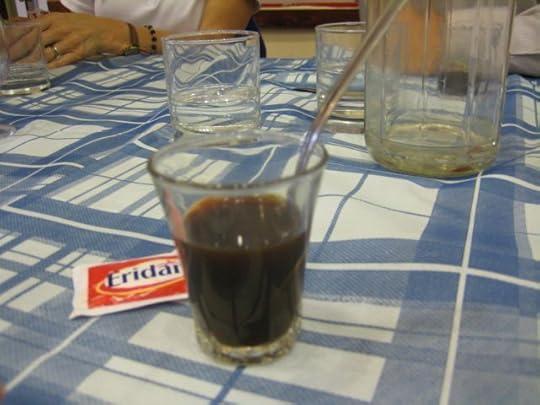 the day will mark you as a tourist, as will a decaf order (caffé hag or decafinato), something that’s not all that common in Italy.
the day will mark you as a tourist, as will a decaf order (caffé hag or decafinato), something that’s not all that common in Italy.
If you really want to drink coffee like an Italian, order it standing at the bar (al banco), which will be much cheaper than a sit-down coffee. You place your order, get a receipt, turn that in to get your coffee order, and then knock it back, like a shot. If it’s morning and you’d like a sweet treat to go with your caffé, I highly recommend cornetto, a lovely croissant-type pastry, sometimes filled with cream. I ate one every single morning with my cappuccino for 11 days straight when I was in Rome. Bellísimo!
We’ll be ordering lots of coffee on our 13-day food-faith pilgrimage of Italy. Want to join us or learn more? Click HERE.
The post Italy 2014: Order coffee like an Italian appeared first on Not Strictly Spiritual.


